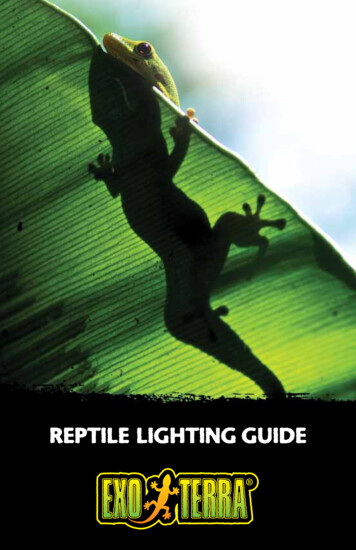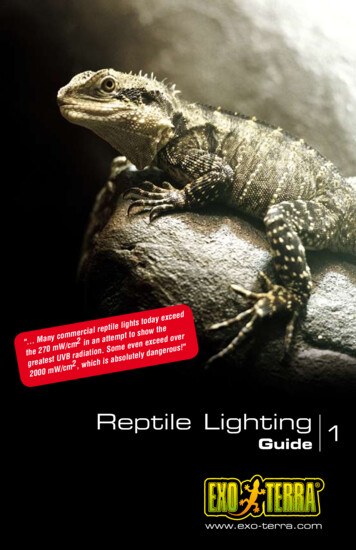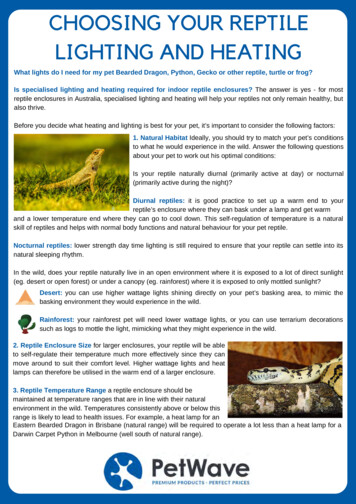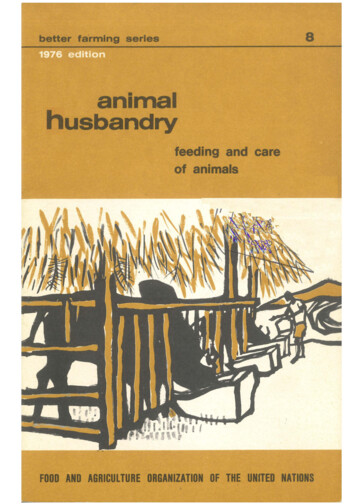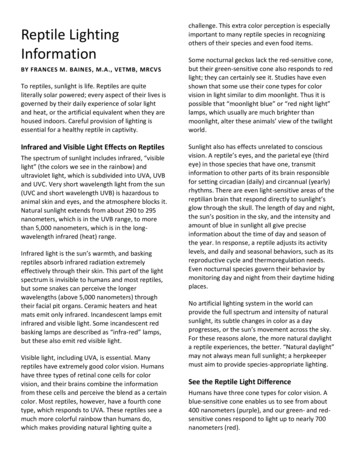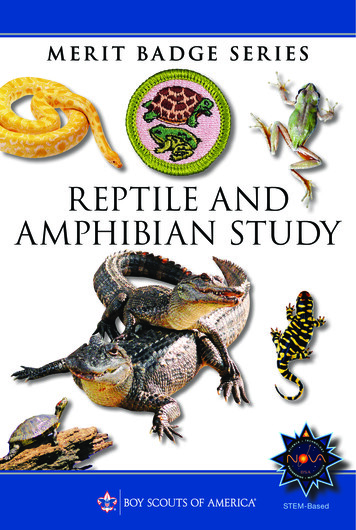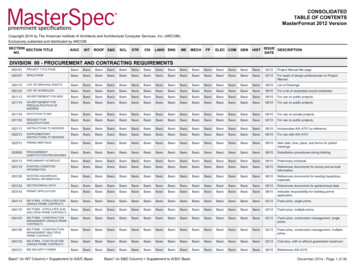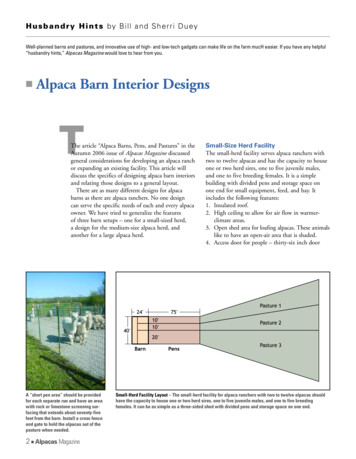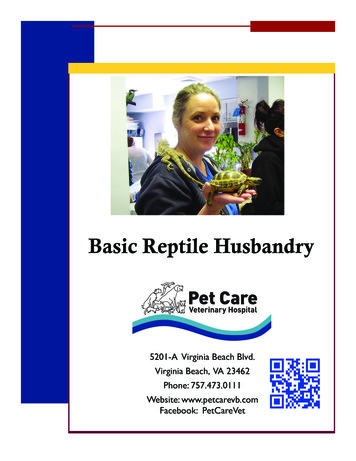
Transcription
Basic Reptile Husbandry5201-A Virginia Beach Blvd.Virginia Beach, VA 23462Phone: 757.473.0111Website: www.petcarevb.comFacebook: PetCareVet
Pet Care Veterinary Hospital5201 Virginia Beach Blvd.Virginia Beach, VA 23462(757) 473-0111Petcare@petcarevb.comBasic Reptile HusbandryReptile husbandry is a tricky topic. Somescaly pets thrive in a broad array of habitats, whileothers (like chameleons) will not thrive unlesseverything is perfect. The following is a generalguide, and if you have specific questions about aspecific animal, look it up on a good website(www.chelonia.org, www.anapsid.org,www.kingsnake.com, and the chameleoninformation network www.animalarkshelter.org/cin/) or in theliterature. The bottom line is that correcting husbandry is a huge part of reptilian veterinarymedicine, as 90% of reptile medical cases involve improper husbandry.The best captive environment simulates the animal’s natural habitat. All organisms havea major habitat & a microhabitat. The major habitat is the general ecosystem that the animallives in (i.e. this is a desert lizard, or a tropical lizard). The microhabitat is the portion of themajor habitat that a particular species uses, including lifestyle & resource use. Microhabitatuse can be very different between species, even in the same geographic location. It is bothharder to understand than the major habitat, and more important to the animal’s well-beingthat we understand it. Elements of the microhabitat include optimal temperature, daylightlength, terrain use (burrowing vs arboreal vs leaf litter vs cave-dwelling), water use, & diet(leaves vs. fruit vs. insects vs. meat, etc.). There are five factors that interact to make theperfect reptile habitat. As stated before, a huge diversity exists between species regardingwhere they live and how they eat. Mimicking these five basic requirements are paramount tosuccessful care for the pet/captive reptile. These five main factors are: 1) Housing, 2)Temperature, 3) Lighting, 4) Humidity, and 5) Water.HousingHousing includes a reptile’s cage, cage furniture, and substrate (bedding material). Theenclosure should resemble the animal’s natural habitat as much as possible. This variesgreatly depending on the origin and habits of the particular species – arboreal, terrestrial,tropical, burrowing, desert, aquatic, or semi aquatic. For instance, an arboreal animal (crestedgeckoes, tree boas) usually requires a taller rather than longer cage. For snakes, thecircumference of the terrarium should be 1.5 times the snake’s length. Enclosures must beescape proof with secure doors and openings. This cannot be over-emphasized! Snakes inparticular are escape artists and cages need to have latching or sliding doors. Wood is lessideal than glass or Plexiglas as it is porous and more difficult to clean and disinfect. Snakemites also love to hide in the cracks in wood cages. Screen or wire can be used with cautionto avoid trauma from sharp edges. Depending on the species and temperament ofindividuals, housing animals together may or may not be a good idea. A veterinary exam and
quarantine period of 60 days should occur before any introduction of new animals into themidst of previously owned individuals.A proper substrate should increase enrichment, decrease stress, be safe, be easy to clean,& be visually appealing (this last one is the least concern, though). Good substrates include:1. Newspaper is ideal in many situations since it is inexpensive, non-toxic, and easy tomaintain, although it is not very attractive.2. Reptile carpet is more appealing and relatively easy to clean. Multiple pieces can becut to fit so one is always clean and dry, ready to be used.3. Care Fresh litter is a good substitute for a loose substrate for a burrowing animal.4. Alfalfa pellets & potting soil have been used as well, but these tend to grow moldeasily once they get wet.AVOID using any sort of particle substrate (corncob, wood chips or shavings, soil, andsand) as these can get stuck in the mouth (leading to stomatitis/mouth rot), exacerbate skinirritation, or cause intestinal obstructions. Even so-called “calcium sands” are NOT always100% digestible: In an unpublished study, Dr. Byron de la Navarre found that calcium sandbreaks down (with significant agitation)at a pH of 1-2 (stomach acid levels) in 2-3 days, at apH of 3-4 in 2-3 months, and never at a pH of 5-6 (small intestine acid levels). Obstructionsseem to be a particular risk in juveniles housed on sand of any kind. In addition, aromaticoils in cedar wood shavings are toxic to reptiles – never use these as cage substrate. Multiplesubstrates can be present in the same terrarium. For instance, the whole bottom can becovered by newspaper, & then a tub with soil can be placed in the cage for digging purposes.Reptiles should NOT be fed on their normal substrate (unless it is newspaper or cagecarpet), as this increases the risk of both foreign body impactions & parasite ingestion.The ONLY animals that should be on sand are sand boas & sand skinks, as they needto hide in it naturally (reduces stress). These animals should still NOT be fed on the sand,and the coarsest grain sand possible is advised. Care Fresh may also make an acceptablealternative to sand for these species.Cage furniture is necessary to provide visualsecurity, a den/seclusion, and natural climbingstructures. Clay pots, flat rocks, plastic and naturalplants, branches, hollow trunks, plastic tubing, andmanufactured dwellings are examples. Furnitureshould include textured items to rub against (whichaid in shedding). Avoid sharp or excessivelyabrasive materials including lava rocks that coulddamage tender new skin. Many habitats usebranches or other climbing material to help theanimal use more of its living space and accessbasking sites. Arboreal animals need secure branches for climbing and resting. If using liveplants, avoid Ficus & Pothos spp. of plants, as these have been linked to conjunctivitis inchameleons.
TemperatureThere are 4 types of physiological heat transfer: radiation, conduction, convection, &evaporation. Evaporation is the most important in terms of heat loss (see humidity section),but our husbandry efforts have the greatest effects with radiation & convection within thecage. All reptiles have a preferred optimal temperature zone (or POTZ) where theirmetabolism runs efficiently. For instance, enzyme activity, blood oxygen carrying capacity,antibody production, digestion, healing rate, and drug activity all function best when theanimal is within its POTZ - for every 5 degrees outside of the POTZ, a reptile’s immunesystem function is cut by 50%. Outside this zone, the animal will exhibit thermal seeking oravoidance activity, and if they are within this zone, they will lose this activity. Appropriatecage set-ups take into account the POTZ and natural circadian (i.e. the daytime andnighttime) cycle habits of the individual. It is extremely important to know the POTZ of theanimal being kept. It is also extremely important to use thermometers to know and maintainthe temperature within the POTZ. Keep in mind the POTZ is a range. A temperaturegradient is needed from the upper to the lower end of the POTZ. The warmer side is wherethe heat source is positioned, often with climbing material for the animal to get closer.Temperature can be supplied as either focal orbackground heat, or both. For basking animals,(most reptiles) focal, radiant heat from above is ideal.Radiant heat is provided by bulbs and/or ceramicheat emitters (ceramic flood bulbs that only give offheat). Choose the appropriate wattage bulb andadjust its distance to achieve the POTZ. Bulbs thatemit white light must be turned off at night toprovide a day-night cycle. With non-snake reptiles,basking lights are usually combined with UV-Blights. Under tank heating pads & room heat bothwork well as background heat sources. If a heatingpad is used, it should be outside the tank, and thepad’s size should not be more than ½ of theunderside of the tank. The heat should be uniform & controlled (think thermostats &rheostats). Heat tape and space heaters are acceptable for larger areas if used with care.All reptile cages should have a thermal gradient within the cage (i.e. the cage should notbe uniformly the same temperature, but be different temperatures in different areas), so thatthe reptile can choose its own temperature suited to its needs at the moment.The most temperature-sensitive part of many reptiles is the head (greater surface-tovolume ratio, so the head cools faster). When the head doesn’t have the correct temperature,the animal will start seeking more or less heat. The body can sense temperature too, but notas well as the head.This is how hot rocks lead to burns: the head is normal while the body is too hot over along time period. DO NOT use hot rocks OR any other in-cage heaters!!Nocturnal reptiles still thermoregulate during the day, so give them a thermal-neutralsubstrate & a heat source all the time.
Use all heat with caution and know the temperature at the hottest and coldest areas ofthe enclosure by using thermometers. A digital thermometer with a probe can be movedaround the cage throughout the day, but otherwise, multiple thermometers will be needed.Allowing the animal to get too close or allowing the heat source to get too hot are seriousproblems that do cause burns and sometimes fatality. Avoid fire hazards as well. For mostindividuals housed indoors, providing heat during the day and having it go off overnight isacceptable as this is similar to natural variations in day/night temperatures experienced in thewild. As a general rule, sick and healing animals should be maintained toward the upper endof the POTZ not allowing nighttime temperatures to drop significantly.General cage temperature setup based upon macro-habitat:1.2.3.4.Desert – Day: 75-95 oF; Night: 65-75 oFTemperate – Day: 72-88 oF; Night: 70-72 oFTropical – Day: 78-100 oF; Night: 72-75 oFAquatic/Semi-aquatic animals – Land: 75-88 oF; Water: 68-75 oFThese are general ranges that species inhabiting these environments should be housedwithin. Exact species information should be looked-up.See additional warning about overheating in the lighting section.Lighting & Calcium/Vitamin D MetabolismLight is important for two reasons. First, it provides a day/night cycle which isimportant for all species. Secondly, light of certain wavelengths (ultraviolet [UV]-B),commonly referred to as “full spectrum” light, are necessary for correct calcium metabolismin many species.The requirement for ultraviolet/full spectrum light is variable, being particularlynecessary for basking lizards and turtles while less critical for snakes (who tend to get all oftheir Vitamin D3 from their whole prey item diet). Crepuscular (active at dawn and dusk)and nocturnal reptiles are more efficient at converting vitamin D3 than diurnal ones, butmost still need UV-B light. In nature, they are still exposed to brief amounts of UV-B light,be it at sunrise and sunset, or from solar light reflecting off of the moon. Recent worksuggests that they may benefit from short durations of low level (2%) UV-B exposure (1-4hours).The relationship of calcium to light is through the skin and vitamin D3. Vitamin D3 isreferred to as the sunshine vitamin because UV-B light wavelengths from the sun helpconvert precursor molecules into active vitamin D3 within the skin. Since vitamin D3’sfunction is to allow intestinal absorption of calcium, it therefore takes both, exposure toadequate UV-B rays and appropriate amounts of calcium in the diet to achieve normalcalcium metabolism. UV-B light includes those wavelengths just shorter than visible light ( 295 nm). UV-A light stimulates behavior & appetite, but it is usually found in all UV lights.Not all light bulbs emit UV-A and/or UV-B rays, hence the need for special bulbs.
Light is often intertwined with heat and brings another factor to the equation. Sunlightis the gold standard for truly full spectrum light plus heat. Sunlight can provide full spectrumlight only if un-obstructed by glass or Plexiglas. This means exposure to the sun from behinda window or glass enclosure only provides light and warmth; it will not aid vitaminD3/calcium metabolism. This also means artificial lights cannot be obstructed by glass orPlexiglas, making screen lids the norm. Please use extreme caution placing animals outdoorsin direct sun, especially inside aquariums, as heat builds up like the inside of a car. Heatexhaustion kills!Three categories of artificial light bulbs are recommended for providing UVB: mercuryvapor, metal halide, and fluorescent. The only good bulb at providing all three elements ofdaylight, heat, and ultraviolet/full spectrum light is the mercury vapor lamp. They providegood UV-B output. Mercury vapor bulbs generally cost about 60-70, and are readilyavailable under different brand names (T-Rex and PowerSun are examples). These looklike flood bulbs and screw into an incandescent fixture. Drop off of UV-B intensity overtime is less of a concern with mercury vapor lamps. Mercury vapor lights should be replacedevery 24 months. With mercury vapor, one bulb does it all!Metal halide lamps provide good to excellent UV-B output and bright light. They donot get very hot, necessitating an additional heat source such as a ceramic heat emitter oranother light bulb. Metal halide bulbs can also be used until they burn out. For metal halidelamp information go to reptileuv.com.Fluorescent bulbs emit moderate to good amounts of UV-B and give off white light.Similar to metal halide bulbs, however, they don’t provide much heat. There are many ofthese bulbs marketed for reptiles and vary in the strength of their UV-B output. These canhave an advantage over mercury vapor lamps by casting light over a larger area of thehabitat, but most baskers spend a lot of time directly under the basking light anyway.Historically all these were straight tubes and fit into long fluorescent fixtures, but now thereare also versions that are made to fit incandescent screw fixtures. Smaller bulbs will decreasethe area over which the light shines. Fluorescent lights should be replaced every 6-12 months(preferably 6) due to UV decay. They should be replaced even if the light is still on (i.e. hasnot burned out).Other forms of light are variations of regular light bulbs and natural light comingthrough windows. These are fine for daylight, a day/night, cycle, and heat, but do notfunction as a source of “full spectrum” (UV-A & UV-B) light. These can be used foranimals that have minimal need for UV-B rays, but this is not recommended. It is generallypreferred to use some form of UV-B emitting bulb or exposure to unfiltered (no glass orPlexiglas) sunlight with reptiles kept in man-made environments, regardless of species. Alsoof note, normal environmental UV-B radiation exposure causes neither sunburn norimmune-suppression in reptiles. However, the heat produced can still burn the reptile, &excess UV-B can sunburn the animal!!As with all light bulbs, the closer to the bulb is to the target, the greater the strength ofits output (in this case, UV-B). This means we want to place bulbs far enough away to notcause burns (remember thermometers!), but close enough to have the desired effect. Metersto measure UV-B are available for testing the actual output strength of the bulb and to
compare bulbs. A good starting place is that fluorescent lights should be placed 12-18 inchesfrom the basking site, and mercury vapor lights should be placed 18-24 inches from thebasking site.Automatic timers make lighting and heating more fool proof and easier. It also makesestablishing a light: dark cycle simple for your reptile.HumidityRelative humidity is the amount of water that the air can hold at a given temperature ascompared to the actual amount of water in the air. As temperatures increase, so does theair’s capacity for holding water vapor. However, the actual amount of water in the air willnot change unless water is added to the system, so with a temperature increase in a waterstable system, relative humidity decreases.All animals will lose water (and heat, via evaporation of water) in environments wherethe humidity is less than 100%. They lose water through their eyes, salivary & nasalsecretions, urinary, fecal, and reproductive secretions, respiration, and during ecdysis(shedding). To minimize water loss, reptiles will be most active during the times of thehighest humidity. They will also exhibit behaviors that have evolved, at least in part, toreduce water loss, such as burrowing in sand or leaf litter, or moving into crevices. Thismeans that desert animals do not live normally at a humidity of 10%, despite being in thedesert. They find areas, such as burrows, with higher humidity and spend the worst parts ofthe day camped out in appropriate microhabitats.Humidity can be measured in your reptile’s terrarium with a hygrometer, or even adigital humidity meter with a probe (made by Exoterra). The probe or hygrometer should bewhere the reptile spends its time, not at the top of the cage. General humidity guidelines forthe major habitats are:1. Desert habitat: 45-65% humidity2. Temperate habitat: 55-70% humidity3. Tropical habitat: 60-80% humidityThese are general ranges that species inhabiting these environments should be housedwithin. For more exact species information, owners are encouraged to check species specificsources in the literature or online.Humidity can be maintained in several ways. Daily, thorough spraying of the cage withwater can be effective if done properly, but it can also result in great variability both inhumidity throughout the day, and the amount of water that actually gets into the cage. Anautomatic mist system is much better (Zoo-Med), as it can adjust to the humidity &temperature throughout the day. Live plants & waterfalls in the cage will also consistentlyadd to the humidity. Ultrasonic foggers tend to break, so avoid them.Weekly or daily (during periods of disease or ecdysis) soaking will help keep the animalshydrated. Soaks should be 10-20 minutes, in lukewarm water. Owners should monitor theanimals during the soaking, so that the pet does not drown.
In addition to the general cage humidity, you can set up specific areas of higherhumidity. The most common method of doing this is to use a hide box with sphagnum mossinside. A second method is to have 2 or 3 “half-logs”. One should be submerged in waterfor an hour, then rotated into the cage while another one soaks.No matter what, the habitat must be ventilated (i.e. a way for air circulation to occur).Humidity without ventilation diseased animals. Adult chameleons especially benefit from ahabitat with screens on multiple sides.Reptile NutritionReptiles can be broken down into three basic dietary groups: carnivores, herbivores, andomnivores. Insectivore is a subset of carnivore, and includes many of the lizard species. Theomnivores are fed as both carnivores and herbivores, utilizing a combined feeding strategy.It is not uncommon for a primary herbivore to enjoy some insects (or an occasional meatitem) or a primary insectivore to eat vegetables. This is why it is important to know specificdetails of the species being cared for. Research each animal’s specific dietary needs toprovide optimal nutrition.If feasible, vary the food items being offered for more rounded nutrition and enjoyment.Aquatic turtles will generally only eat in the water. Snakes are often fed virtually the samediet lifelong, graduating to larger prey items. However, some snakes (especially indigosnakes) may do better on a varied diet (i.e. rodent, chick, lizard, and frog prey items).Frequency of feeding also varies greatly. Most animals should be fed daily, especiallyimmature lizards and turtles. Snakes are fed once every 5 to 14 days. Snakes should not befed just before or during a shed when their eyes are cloudy.HERBIVORES:Tortoises and lizards such as the green iguana, desert spiny tail (Uromastyx spp.), andchuckwalla are herbivores. Other lizards and turtles that are omnivores also get fed some oftheir diet from vegetation; bearded dragons, sliders, and boxturtles are examples.Much variety exists for the herbivore. Dark leafy greens makeup the bulk of their diet. Mustard greens, collards, kale,romaine and leaf lettuce (avoid head lettuce such as iceberg),bok choy, radicchio, spinach, broccoli, green beans, peas,alfalfa sprouts, escarole, zucchini and yellow squash, parsley,lima beans, yams, corn, carrots, beet greens, dandelion flowersand greens, Swiss chard, bell peppers, Brussels sprouts, andmixed vegetables are all appropriate. Grasses and hays can andshould be fed to larger tortoises. Timothy and alfalfa rabbit pellets can also be fed toherbivorous reptiles, but many of them have pelleted foods specifically for them as well (ex:ReptoMin, Mazuri, etc.)
Fruits and berries can make up part of the diet but should be limited to approximately 1015%. Such items include raspberries, melons, strawberries, blackberries, peaches, banana,mango, kiwi, apple, blueberries, and cherries.CARNIVORES:All snakes, as well as, many lizards and some turtles are carnivores. Aquatic turtles tend to bemore carnivorous than terrestrial turtles. Much variety exists as to what food items are fed toand eaten by carnivores. These animals eat whole prey items such as mice, rats, rabbits,chicks, insects, feeder fish, earthworms, and slugs.Other meat-based foods can be offered to carnivores,such as dog food, fish flakes, aquatic turtle pellets,trout chow, cooked scrambled egg, primate chow, andsmall amounts of cat food. Dog and cat food are onlyto be used when the reptile will eat nothing else, asthese diets are very high in protein, and can lead togout. Also, avoid or limit frozen fish in the diet, as thiscan lead to a thiamine (a.k.a. Vitamin B1) deficiency.Some insectivores can rarely be fed whole prey items (this works well for adult leopardgeckoes, which can get a pinkie mouse 1-2 times a month – a great source of Vitamin A forthem)Never feed carnivores a diet of only muscle/meat (such as ground beef or chicken breasts)as this will lead to severe nutritional deficiencies. Whole prey animals MUST be givenbalanced and complete rations to ensure they become a well-balanced meal. Pre-killed,frozen thawed mice, rats, or birds are recommended (if the animal will accept it) for multiplereasons:1. It avoids suffering of the prey animal.2. It prevents bite trauma to the reptile.3. It reduces the bacteria & parasite loads that your pet will receive with any given mealAs Vitamin E slowly leeches out of frozen rats, mice, & birds, do not get more than a 6month supply of these food items at any one time.INSECTIVORES:This group includes geckoes, chameleons, and a few otherreptiles. Invertebrate diets can include crickets,mealworms, cockroaches, earthworms, superworms,hornworms, and other prey items. The invertebrates mustalso be fed a balanced diet to be a nutritious food for areptile. The term “gut loading” describes offering healthyfoods to insects prior to them being fed as prey.Commercial gut load diets are available for crickets andsome other insects, and can be a dry or a gel-like consistency. It is preferred to use dryformulas and offer water separately. Do not use bowls of water as the insects may drown –instead use soaked paper towels or sponges to give the prey their daily water. Some of thefeeder crickets will die no matter what, so the cricket container will need regular cleaning of
the dead crickets and waste material. DO NOT feed insects with an unhealthy appearance toyour reptile. DO NOT offer fireflies, as some firefly species are very toxic to reptiles.Do not EVER leave live, uneaten prey (vertebrate or invertebrate) unattended in the reptile’senclosure. Severe bite injury can occur from both mice/rats and insects that are leftunattended and become hungry themselves. An exception can be made for worm insectsoffered from a bowl in which they cannot climb out.OMNIVORES:Omnivore dietary rations are comprised of ingredients from both herbivore and carnivorecategories. Specifics vary widely with respect to percentages and items from each categorydepending on the particular species.Common omnivorous reptiles include boxturtles, sliders (rarely eat vegetable matter thatfalls into water), red-footed tortoises(occasionally eat carrion), bearded dragons,water dragons, tegu lizards, and blue tongueskinks.Particular dietary requirements must beresearched for each type of animal. Theaquatic turtles tend to be carnivorous asjuveniles and become more omnivorous with maturity. Aquatic turtles should be fed inwater as it is their normal way of eating. For bearded dragons and chameleons, someresearchers suggest a mixed insect diet to improve their dental health (such as adultmealworms & roaches in addition to crickets and mealworm larvae).Dietary supplements:Experience with feeding reptiles has led to the current recommendation of supplementingvitamins and minerals to many of the lizard and turtle species. Supplements are usually notnecessary for carnivorous animals, including snakes, monitor lizards and snapping turtlesthat eat whole prey such as mice, rats, chicks, and rabbits. It is very important, however, tosupplement insectivore, omnivore, and herbivore diets with calcium and other minerals plusmultivitamins. Use powder supplements not spray products.Supplements are administered differently to growing juveniles than for mature adults.During growth, calcium requirements are the greatest, leading to increased amounts added tothe diet for young animals. With maturity, calcium needs are diminished and thereforelimited amounts of calcium are added to adult rations. Too much calcium and/or vitamin Din adult reptiles will cause problems (namely, mineralization of soft tissues).For juveniles, alternate between two products: a multivitamin/mineral supplement used oncea week, and a calcium/vitamin D only supplement used 3-5 times weekly (so most meals aresupplemented). Sprinkle and mix the powdered supplement into veggies and shake insectprey in the powder prior to offering as food.For adults a calcium/vitamin D supplement should be added to the diet about twice weeklyfor herbivores and shaken onto insect prey 2-3 times weekly for insectivores. Remember,
insects should also be “gut loaded” to become optimal nutrition. A multivitamin withoutvitamin D should be offered once every 1-2 weeks. Supplements are typically not neededfor aquatic turtles that are fed some amount of commercial aquatic turtle food.The type of vitamin A given to a reptile in the multivitamin should also be considered. Betacarotene (or “pre-vitamin A”) is appropriate for herbivores and some omnivores, as thesereptiles can convert it into vitamin A. However, other omnivores (iguanas), and insectivores(geckoes, chameleons) should only get pre-formed vitamin A (also known as retinol), as thebeta-carotene will be useless to them.Nutritional secondary hyperparathyroidism, betterknown as nutritional metabolic bone disease, is acommon problem in improperly supplemented reptiles.The animal’s body will maintain blood calcium at theexpense of bone calcium, so that bones become soft &pliable over time. The animal gets weak, doesn’t eat asmuch, may have flexible jaws or long bones, and candevelop twitches or seizures in extreme cases.Aspects of husbandry & diet that can lead tonutritional metabolic bone disease:1.2.3.4.5.6.Lack of UV-B light exposureImproper temperature rangesDecreased calcium in the dietDecreased Vitamin D3 in the dietToo much phosphorous in the dietAnything that causes improper absorption of calcium or Vitamin D3 from theintestine (low vitamin A, parasites)7. Any combination of the aspects listed aboveWater:Water is a nutritional requirement for all animals and, in addition, is a vitalenvironmental/habitat requirement for many reptiles. Water requirements are just asimportant to know as the dietary needs for each type of reptile kept.Aquatic turtles need an appropriate aquarium with good filtration and frequent (weekly tomonthly) water changes. It is recommended to de-chlorinate municipal water after a waterchange to prevent irritation to eyes. A “haul out” area or platform is essential for aquaticturtles to bask.Some chameleons and snakes need high humidity to replicate rain forest conditions. This isaccomplished with water misting from spay bottles, drip systems, and automatic watermisting systems. Monitor humidity in the enclosure with a hygrometer. Most terrestrial andarboreal reptiles should have a water source in their enclosure, referred to as a soak pit,which allows them to enter and exit this “pool” safely. Some arid species do not require asoak pit and get all their water from their diet.
Most chameleons enjoy running or dripping water, and many lizards (especially chameleons)WILL NOT drink from a standing water source (like a bowl). Instead they will lap waterdroplets from plants, cage furniture, and themselves after misting. It is also a good idea tosprinkle water onto the greens and vegetables for herbivores.What Is A Humid Hide?A humid hide is a microenvironment with a higher humiditythan the rest of the enclosure. It is useful to include in almostall reptile enclosures to allow your pet to have access to a higherhumidity when needed such as times when your reptile isshedding. Making a humid hide is generally inexpensive andsimple!All you need to build a humid hide is anappropriate sized plastic container thatyour reptile can easily fit inside (and caneasily fit inside of your reptile’s habitat),either sphagnum moss or damp papertowels as the substrate inside, andsomething to cut the plastic. You canobtain an appropriate sized plasticcontainer by purchasing Tupperware oreven by using old butter or sour creamcontainers (make sure they have beenclean
Basic Reptile Husbandry Reptile husbandry is a tricky topic. Some scaly pets thrive in a broad array of habitats, while others (like chameleons) will not thrive unless everything is perfect. The following is a general guide, and if you have specific questions about a specific animal, look it
